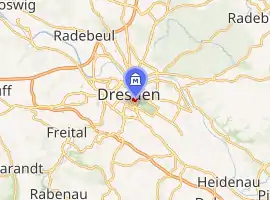German Hygiene Museum
The German Hygiene Museum (German: Deutsches Hygiene-Museum) is a medical museum in Dresden, Germany. It conceives itself today as a "forum for science, culture and society".[1] It is a popular venue for events and exhibitions, and is among the most visited museums in Dresden, with around 280,000 visitors per year.[2]
 Entrance area | |

| |
| Established | 1912 |
|---|---|
| Location | Lingnerplatz 1 01069 Dresden, Germany |
| Type | Medicine, health promotion |
| Visitors | 280,000 |
| Website | German Hygiene Museum |
History

The museum was founded in 1912 by Karl August Lingner, a Dresden businessman and manufacturer of hygiene products, as a permanent "public venue for healthcare education", following the first International Hygiene Exhibition in 1911.[3][4]
The second International Hygiene Exhibition was held in 1930-31, in a building erected west of the Großer Garten park according to plans designed by Wilhelm Kreis, which became the museum's permanent home. One of the biggest attractions was, and remains, a transparent model of a human being, the Gläserner Mensch or Transparent Man, of which many copies have subsequently been made for other museums.[4][5]
During the Third Reich the museum came under the influence of the Nazis, who used it to produce material propagandising their racial ideology and promoting eugenics. Various Nazi government offices relocated to the museum between 1933 and 1941,[6] and the German Labour Front's Reichsberufswettkampf (National Vocational Competition) was held there in 1944. Large parts of the building and collection were destroyed by the bombing of Dresden in 1945.[4][5]
In the East German period the museum resumed its role as a communicator of public health information. It produced a wide range of educational material, including short films on subjects such as smoking, breastfeeding, sexually transmitted diseases and teenage pregnancy.[7] In 1988 the museum, working in co-operation with East German gay and lesbian activists, commissioned DEFA film studios to make the documentary film Die andere Liebe (English:The Other Love), the first East German film that dealt with the subject of homosexuality.[8] The museum also commissioned the only HIV/AIDS prevention documentary produced in the GDR, Liebe ohne Angst (Love without fear) in 1989.[9]
Following German reunification the museum was reconceived and modernised, starting in 1991. In 2001 it was included in the German government's Blue Book, a list of around 20 so-called "Cultural Lighthouses" – cultural institutions of national importance in the former East Germany – in an association called the KNK. Between 2001 and 2005 the museum was renovated and partly rebuilt under the architect Peter Kulka.[4][5][10]
Exhibitions, collection and other activities

The museum's permanent features are the exhibition "Human Adventure" (Abenteuer Mensch), covering the human race, the body, and health in its cultural and social contexts, and a children's museum of the senses.[11]
The museum owns an extensive collection of around 45,000 items documenting the public promotion of bodily awareness and healthy day-to-day behaviour, mostly from the early 20th century onwards.[4][5]
There is a regular program of temporary exhibitions on social or scientific issues. Recent examples have included "Religious Energy", "What Is Beautiful?" and "War and Medicine". The museum also organises scientific and cultural events, including talks, meetings, debates, readings, and concerts.[4][12]
Further reading
- Thomas Steller. „Kein Museum alten Stiles“. Das Deutsche Hygiene-Museum als Geschäftsmodell zwischen Ausstellungswesen, Volksbildungsinstitut und Lehrmittelbetrieb von 1912 bis 1930 in: Sybilla Nikolow (Ed.): Erkenne dich selbst – Strategien der Sichtbarmachung des Körpers in der Arbeit des Deutschen Hygiene-Museums im 20. Jahrhunderts, Böhlau 2015.
- Thomas Steller. Volksbildungsinstitut und Museumskonzern. Das Deutsche Hygiene-Museum 1912-1930, Bielefeld 2014, online: http://pub.uni-bielefeld.de/publication/2724840.
- Thomas Steller. Seuchenwissen als Exponat und Argument – Ausstellungen zur Bekämpfung der Geschlechtskrankheiten des Deutschen Hygiene-Museums in den 1920er Jahren in: Malte Thiessen (Ed.): Infiziertes Europa. Seuchen im langen 20. Jahrhundert. München: Oldenbourg DeGruyter 2014.
- Sybilla Nikolow und Thomas Steller. Das lange Echo der Internationalen Hygiene-Ausstellung in: Dresdener Hefte 12 (2011).
- Paul Weindling. Health, Race and German Politics between National Unification and Nazism, 1870-1945. Cambridge Monographs in the History of Medicine, (Cambridge: Cambridge University Press, 1989)
References
- A forum for science, culture and society Archived 2011-04-04 at the Wayback Machine (in English)
- Lernort Museum – Wie wollen wir leben? Ethische Debatten im Museum (in German)
- Hygiene Ausstellungen Lingner-Archiv. (in German)
- Kulturberichte 1/01: Stiftung Deutsches Hygiene-Museum Arbeitskreis selbständiger Kultur-Institute e.V. (in German)
- Deutsches Hygienemuseum Dresden fertig saniert Archived 2012-03-19 at the Wayback Machine City of Dresden. 12 November 2010. (in German)
- Bilder vom Menschen – Geschichte und Gegenwart: Die Dauerausstellung des Deutschen Hygiene-Museums in Dresden Susanne König. In Studies in Contemporary History, 4 (2007). (in German)
- Frackman, Kyle (2016) The Other Love in the Other Germany: East German Film, Media, and Social Change for Gay Rights, p. 5. Presented at the Canadian Association of University Teachers of German annual conference on 30 May 2016 in Calgary, Alberta. Retrieved 7 July 2018
- The Other Love (Die andere Liebe) on DEFA Library website. Retrieved 6 July 2018
- Love Without Fear (Liebe ohne Angst) on DEFA Library website. Retrieved 21 January 2019
- Deutsches Hygiene Museum: Monumentale Mischung aus Neoklassik und triumphierender Moderne Das Neue Dresden. (in German)
- German Hygiene Museum. Exhibitions. Retrieved 6 July 2018 (in English)
- German Hygiene Museum. Archive. Retrieved 6 July 2018 (in English)
External links
| Wikimedia Commons has media related to German Hygiene Museum. |
